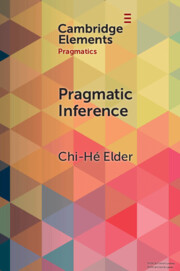Refine search
Actions for selected content:
4 results
Chapter 15 - Haunted by a Good Outcome
- from Part IV - Withholding Therapy with a Twist
-
-
- Book:
- Complex Ethics Consultations
- Published online:
- 17 May 2025
- Print publication:
- 05 June 2025, pp 121-126
-
- Chapter
- Export citation
13 - Evidencing Conversation-Analytic Claims: How Participants Orient to Social Action
- from Part IV - Evidence
-
-
- Book:
- The Cambridge Handbook of Methods in Conversation Analysis
- Published online:
- 06 December 2024
- Print publication:
- 05 December 2024, pp 315-355
-
- Chapter
- Export citation

Pragmatic Inference
- Misunderstandings, Accountability, Deniability
-
- Published online:
- 19 March 2024
- Print publication:
- 21 March 2024
-
- Element
- Export citation
7 - (Mis/Non)Understanding in Intercultural Interactions
- from Part II - Key Issues in Intercultural Pragmatics Research
-
-
- Book:
- The Cambridge Handbook of Intercultural Pragmatics
- Published online:
- 29 September 2022
- Print publication:
- 20 October 2022, pp 164-186
-
- Chapter
- Export citation
